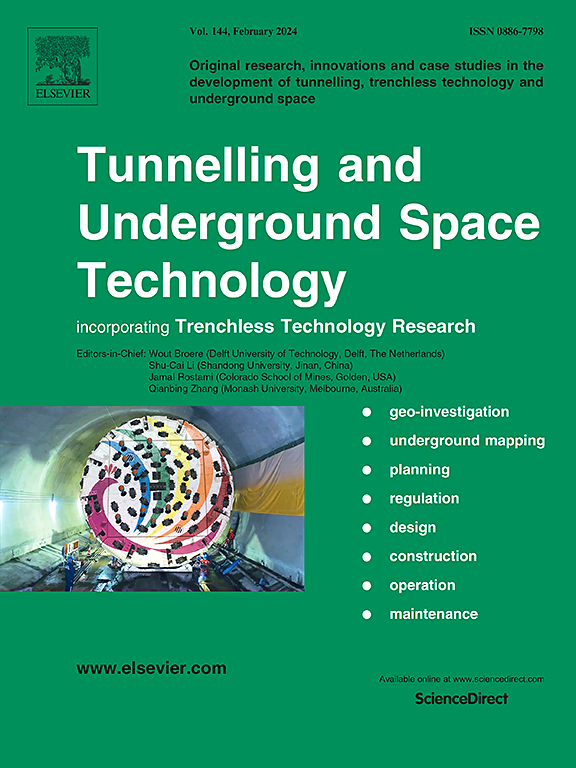Regulating multi-directional passenger flow: Impact of obstacle position and flow level on pedestrian merging process
IF 7.4
1区 工程技术
Q1 CONSTRUCTION & BUILDING TECHNOLOGY
引用次数: 0
Abstract
Mass passenger flow and crowd gathering in subway stations raise the potential of crowd accidents. To improve the safety level in subway stations, it is crucial to investigate the crowd movement characteristics within specific structures with higher risk levels and regulate the passenger flow. The merging structure is common in subway stations with a larger scale of complex multi-directional movements and always be considered a potential bottleneck. It has been proven that specific geometric constraints in merging structures can significantly reduce traffic efficiency and expedite the formation of congestion by aggravating the conflicts among the crowds. However, there is still a lack of research on measures to improve the performance of existing merging structures. Previous findings show that properly set obstacles may increase the performance of bottleneck regions, which provides an opportunity to consider whether the obstacle effect can also be observed during the merging process. From this perspective, we carried out 39 groups of controlled experiments to investigate the impact of obstacle positions on the merging process under three different flow levels. A real human was used as the obstacle, and the distribution of different obstacle positions was divided into three regions. Our results demonstrate that setting the obstacle in certain regions will increase the performance of merging structures in terms of average outflow, velocity, and local density. The average velocity and outflow are increased by up to 6.82 % and 11.26 %, while the local density within the merging area is kept below 3.5 m−2. In contrast, some other regions will generate less efficient outcomes and cause a higher probability of jamming on the merging process. The maximum reduction of average velocity and outflow is 30.99 % and 19.45 %, and the local density can exceed 5 m−2. The performance of different obstacle positions is also affected by the flow level, and controlling the flow at a lower level is more beneficial for the merging process. Other microscopic parameters, such as channel utilization, detour degree, and personal distance, are also introduced to compare the impact of obstacle setups on pedestrian behaviors. The results provide a feasible way to improve the efficiency and safety level of merging structures in subway stations.
调节多向客流:障碍物位置和流量水平对行人合流过程的影响
地铁站内大量的客流和人群聚集,增加了发生人群事故的可能性。为了提高地铁车站的安全水平,研究特定高危结构内的人群运动特征,调控客流是至关重要的。合并结构在规模较大的复杂多向运动的地铁车站中较为常见,一直被认为是一个潜在的瓶颈。事实证明,合并结构中特定的几何约束会通过加剧人群之间的冲突而显著降低交通效率,加速拥堵的形成。然而,对于如何提高现有合并结构的性能,目前还缺乏研究。以往的研究结果表明,适当设置障碍物可以提高瓶颈区域的性能,这为考虑在合并过程中是否也可以观察到障碍物效应提供了机会。为此,我们开展了39组对照实验,研究了三种不同流量水平下障碍物位置对合并过程的影响。以真人为障碍物,将不同障碍物位置的分布划分为三个区域。结果表明,在特定区域设置障碍物可以提高合并结构在平均流出量、速度和局部密度方面的性能。平均流速和流出量分别提高了6.82%和11.26%,而合并区内的局部密度保持在3.5 m−2以下。相比之下,其他一些区域将产生效率较低的结果,并在合并过程中造成更高的干扰概率。平均流速和流出量最大降幅分别为30.99%和19.45%,局部密度可超过5 m−2。不同障碍物位置的表现也受到流量水平的影响,将流量控制在较低的水平更有利于合并过程。其他微观参数,如通道利用率、绕行程度和个人距离,也被引入来比较障碍物设置对行人行为的影响。研究结果为提高地铁车站合流结构的效率和安全水平提供了一条可行的途径。
本文章由计算机程序翻译,如有差异,请以英文原文为准。
求助全文
约1分钟内获得全文
求助全文
来源期刊

Tunnelling and Underground Space Technology
工程技术-工程:土木
CiteScore
11.90
自引率
18.80%
发文量
454
审稿时长
10.8 months
期刊介绍:
Tunnelling and Underground Space Technology is an international journal which publishes authoritative articles encompassing the development of innovative uses of underground space and the results of high quality research into improved, more cost-effective techniques for the planning, geo-investigation, design, construction, operation and maintenance of underground and earth-sheltered structures. The journal provides an effective vehicle for the improved worldwide exchange of information on developments in underground technology - and the experience gained from its use - and is strongly committed to publishing papers on the interdisciplinary aspects of creating, planning, and regulating underground space.
 求助内容:
求助内容: 应助结果提醒方式:
应助结果提醒方式:


